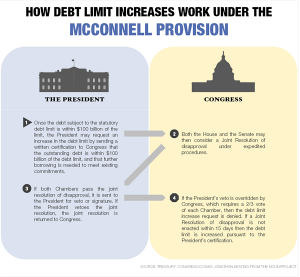There was a while there while all the media talked about was the debt ceiling. And for good reason, since it was a point of contention that our lawmakers in Congress had trouble finding a compromise (that was an understatement).
The Republicans wanted to address spending issues before raising the debt ceiling, and the Democrats wanted to raise the debt ceiling first, and address spending later.
No one budged, and so we got a partial government shutdown. Fun times.
What Is A Debt Ceiling And Why Do We Have One?
The debt ceiling is the maximum amount of debt that the United States is legally allowed to have. The best (imperfect) analogy is to say that it is like your credit card limit — it limits how much you can spend before having to pay off some debt (or in this case, raise your limit).
Originally, government borrowing was approved by Congress on a case by case basis. But thanks to the World Wars, Congress decided to make a general limit on all federal debt.
That sounds like it was meant to give Washington some accountability when it comes to fiscal matters. However, the Debt Ceiling Law actually gave the executive branch the ability to take on debt (and issue bonds) without the approval of Congress, as long as the total debt was under the ceiling.
That means it was a transference of a large amount of fiscal discretion from the Legislative Branch to the Executive Branch.
(It may have been a practical measure in wartime, but it was nonetheless a tipping of the scales, altering the balance of powers. But I digress.)
But Isn’t It Still A Good Thing To Have A Debt Ceiling?
Yes, technically, it’s better to have a ceiling than not have one. With the ceiling, Washington is forced to take a look at its spending habits every so often and (in theory) make responsible adjustments.
If spending could go on forever unchecked, that would be bad, since the burden of debt ultimately falls on the shoulders of hard-working Americans.
However, Congress keeps raising the debt ceiling, so for all intents and purposes, it has no practical effect. It seems like Washington views it as more of an annoyance than anything else.
What Was Different About The Latest Agreement?
 This latest agreement included something called the McConnell Provision, that was put forth by Senator McConnell in the 2011 fiscal cliff debates. It disappeared then, but it was included in the agreements to end the government shutdown.
This latest agreement included something called the McConnell Provision, that was put forth by Senator McConnell in the 2011 fiscal cliff debates. It disappeared then, but it was included in the agreements to end the government shutdown.
This provision changes the way that the debt ceiling is managed. Rather than requiring Congress to pass a law to increase the debt ceiling (as was previously the case), it gives the President the ability to request an increase when the country is within $100 billion of the limit. Congress can then pass a Joint Resolution to reject the request, which of course the President would veto. So it would require a super-majority (2/3 vote from each chamber) to overturn the veto and prevent the ceiling from being raised. If no Joint Resolution of disapproval is passed within 15 days, then the debt limit is increased according to the President’s request.
Basically, that means that anytime the President wants to raise the debt ceiling, he can, unless 2/3 of Congress doesn’t want him to.
However, a timeline was added to keep this power in check: in January, the debt ceiling will kick back in just above whatever spending levels we reached in the meantime. Congress would then need to vote to raise the limit again.
But if they voted to suspend it once, why wouldn’t then do it again? If they’re getting tired of the negotiating headaches, what’s to say that they won’t just suspend it for a longer period of time? Or even permanently?
The debt ceiling has been raised 74 times since March of 1962. The way our monetary system is designed (that’s a topic for another post) practically requires that it will keep getting raised.
So We’ve Got Lots of Debt …Now What?
First of all, don’t pattern your personal budget after the federal budget. It won’t work.
The government can get away with large amounts of debt (for now), but if you run up all your credit cards and keep asking to have the limits raised, you’ll find yourself bankrupt before you know it.
Make sure you understand how to make a monthly budget, how to monitor your budget, and how to save money. If you already have a handle on budgeting, consider learning some investment strategies.
By getting your own finances in line, you’ll be better prepared to weather the storm if the debt debacle ever comes to an impasse (such as could happen if Congress really does veto a spending increase request).
Don’t wait any longer – take charge of your finances today!






Recent Comments